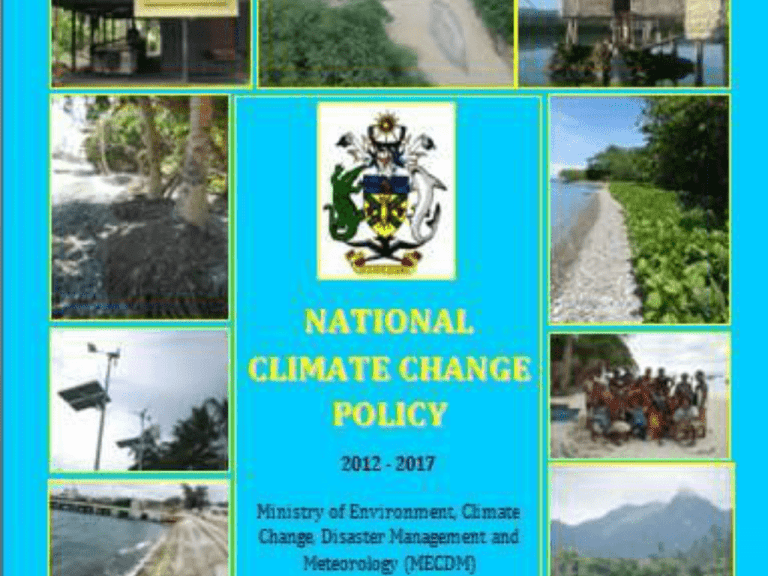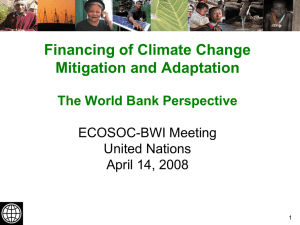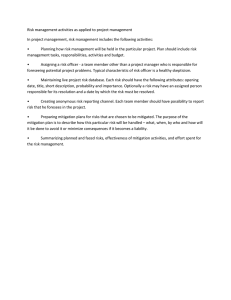Document 16010647
advertisement

Overview • • • • • • Rationale Context and Linkages Objectives Commitments Guiding Principles Policy Themes, Directives and Strategies Rationale • Recognition that CC is a sustainable development issue with challenges and opportunities • Realisation that Achievement of optimum economic growth to support the rapidly growing population will require scaling up economic activities and utilization of natural capital that will give rise to environmental problems and increased GHG emissions • Acknowledges that apart from adaptation, an important solution to CC are some of the natural environmental settings and the services they provide such as in the forest. • Recognising the need to provide a strategic framework to address CC challenges and benefit from opportunities that it brings and to position the country in the phase of a growing range of global innovative financing Context and Linkages • An expression of S.I. Commitment to regional & international MEAs • Articulates from and linked to frameworks of national, regional and international policies and strategies • Alignment with the NDS (obj. 7&8) • Draws from regional frameworks such as the PIFACC and the Regional Framework on Disaster Risk Reduction and Disaster Management • Guided by international commitments (e.g UNFCCC, KP, Hyogo Framework on DRM) Objectives To provide a guiding framework to: 1. Integrate CC consideration and support the implementation and achievement of the S.I. NDS and other regional and international frameworks 2. To guide the government and its development partner’s efforts to ensuring that: – the people, natural environment and economy are resilient and able to adapt to adverse impact of CC – the country benefits from renewable energy, energy efficiency and clean mitigation technologies that improves livelihoods and national economy and contributes to global efforts to reduce GHG Commitments • Sees mainstreaming as integral part of its national development strategy and programs • Recognises that people, natural environment and economy of S.I. are very vulnerable to climate variability and the predicted impacts of CC • Sees the importance of developing capacities to reduce risk and raise ability to adapt to the impacts of CC and to implement measures to reduce GHG emissions • Important to forge and maintain partnerships and seek the support of its development partners through programs and projects for the implementation of this policy Guiding Principles • Guided by the National Constitution • Seeks the participation and collaboration of all Stakeholders • Looks at a holistic and multi-disciplinary approach • Emphasis on precautionary principle and noregrets approach • Calls for the respect for culture and rights of indigenous people • Recognizes gender equity and involvement of youth, children and people with special needs Policy Themes, Directives and Strategies 1. 2. 3. 4. 5. Enabling environment and institutional arrangement to plan, implement and coordinate an integrated and multi-stakeholder participatory approach to addressing CC Mainstreaming of CC into all development sectors and integrated into the work of government agencies, national institutions, civil society organisations and the private sector Vulnerability and adaptation and disaster risk reduction to asses vulnerabilities and risks associated with climate variability and change and to reduce the risks and adapt to the impacts of CC CC Mitigation through appropriate measures and actions in its effort to reduce S.I. GHG emission. Research and systematic observation to ensure better understanding of CC at all levels and sections of society for effective planning and implementation appropriate adaptation and mitigation actions Policy Themes, Directives and Strategies ...... Cont. 6. Technology transfer to enhance the country’s capacity to carryout effective adaptation and mitigation actions 7. Education, awareness and capacity building to strengthen the capacity of nationals, provincial and community organisations and human resources for the effective planning and implementation of appropriate CCA and RR and mitigation actions 8. Finance and resources mobilisation to support CC programs and projects 9. Develop and maintain strong partnerships and cooperation with national partners, stakeholder, regional and international organisations and institutions and development partners to address CC 10. Establishment of monitoring and evaluation mechanism to ensure implementation of this policy Enabling environment and institutional arrangement. • Strengthen capacity of the Climate Change Division as the government lead agency overseeing climate change to lead, guide and coordinate national programs and actions addressing climate change, and coordinate preparations and participation in international climate change negotiations. • Draft and enact national climate change legislation to give legal mandate to the government lead agency responsible for climate change and its associated coordinating and implementation bodies and that shall also include provisions for mandatory assessments and reporting for purposes of planning, implementing and evaluating climate change adaptation and mitigation actions. • Establish a National Climate Change Council to oversee the implementation, coordination, monitoring and evaluation of national climate change policies and strategies. Enabling environment and institutional arrangement. • Establish a Climate Change Working Group (CCWG) to provide interagency and inter-stakeholder coordination for the implementation of the policy. The Membership, scope and role of the CCWG is presented in Annex 5. • Strengthen capacity of the government lead agency overseeing climate change to be the Secretariat of the National Climate Change Council. • Enhance the role and capacity of the Environment and Conservation Standing Committee of Parliament to include oversight over Climate Change. • Develop national and provincial level climate change policies and strategies that is in line with the NDS and other national sector policies and National Disaster Management Framework. Enabling environment and institutional arrangement. • Establish national Thematic Working Groups (TWG) to provide technical and strategic support and advice to the lead agency and National Climate Change Council on climate change issues. The working groups shall oversee the following climate change thematic areas; · Vulnerability, disaster risk reduction and adaptation; · Mitigation & Green house gas inventory; · Research, Systematic Observation and Technology Transfer; and · Education, awareness and capacity building. Enabling environment and institutional arrangement. • Establish formal climate change coordination arrangements within Provincial Governments using existing or new coordinating bodies. • Designate officials as Climate Change Focal Points within national and provincial government Ministries and Departments as well as national institutions and civil society organizations • Establish community-based or village-based climate change coordination arrangements using existing or new coordinating bodies. Mainstreaming of Climate Change • a) Support organizations and institutions build capacity for mainstreaming climate change. • b) Review and revise existing relevant legislations and regulations to support climate change adaptation and mitigation. • c) Review national and provincial government policies & strategies and integrate climate change considerations. • d) Integrate climate change considerations into the planning and budgeting processes of national and provincial governments. • e) Mainstream climate change considerations in country partnership arrangements with regional agencies, international agencies and donors • f) Ensure that the National Development Strategy and other national sector strategies are fully climate compatible within their stated time frames. Thank You





